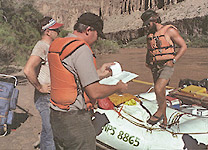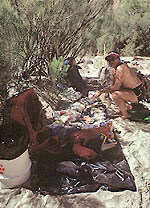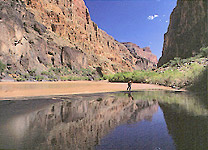
Ultimate Grand Canyon Backpack (Cont'd)
(Page 3 of 9)

 After six days we reached Parashant and coincidentally met the National Park Service monthly patrol who agreed to take us across the muddy Colorado. With clothes dirty and in tatters, you can imagine our amusement when the first response to our request for a ride across was a serious "Can we see your permit please?" We expected them to ask how we got to where we were and if we were trying to kill ourselves. Officialdom will have its day and once the required five page hiking permit was reviewed for completeness, a less serious discussion of our activities took place and they helped us complete our first crossing.
After six days we reached Parashant and coincidentally met the National Park Service monthly patrol who agreed to take us across the muddy Colorado. With clothes dirty and in tatters, you can imagine our amusement when the first response to our request for a ride across was a serious "Can we see your permit please?" We expected them to ask how we got to where we were and if we were trying to kill ourselves. Officialdom will have its day and once the required five page hiking permit was reviewed for completeness, a less serious discussion of our activities took place and they helped us complete our first crossing.
The heavy brush had been our biggest problem up to this point but now the lava intrusions made repeated climbs away from the river necessary. River traffic increased and we finally contacted a rafting trip run by Canyoneers of Flagstaff AZ. Their head boatman for this trip, Jim Norton, assured us that our Whitmore Wash cache was at the base of the trail. He would be our sole provisioner at the two resupply points in the more remote lower reaches of the Canyon. The Park Superintendent had agreed to these caches only if the concessionaire agreed to remove the empty barrels no later than their next trip. Canyoneers owner, Gaylord Staveley had also graciously volunteered to relay weekly messages to my family in Phoenix for as long as their rafting season lasted.
 The Colorado had been flowing muddy from the heavy rain storm on the Paria, Little Colorado, and Kanab Creek watersheds. This was the same storm that had earlier welcomed us to Grand Canyon. A week of drinking heavily-silted, untreated water finally caught up with both of us at Whitmore Wash. The intestinal distress and dysentery lasted for only twelve hours but it was enough to bring health problem concerns to the surface. We knew that both of us had to remain healthy for eight weeks. Rescheduling our trip might be possible but it would result in considerable familial concern in Phoenix, as well as eat up precious supplies, possibly requiring additional unplanned food drops.
The Colorado had been flowing muddy from the heavy rain storm on the Paria, Little Colorado, and Kanab Creek watersheds. This was the same storm that had earlier welcomed us to Grand Canyon. A week of drinking heavily-silted, untreated water finally caught up with both of us at Whitmore Wash. The intestinal distress and dysentery lasted for only twelve hours but it was enough to bring health problem concerns to the surface. We knew that both of us had to remain healthy for eight weeks. Rescheduling our trip might be possible but it would result in considerable familial concern in Phoenix, as well as eat up precious supplies, possibly requiring additional unplanned food drops.
 Reprovisioned at Whitmore, we continued upstream for four more relatively easy river miles until we were finally blocked by a towering black lava intrusion rising several hundred feet above the river level. Our research of Grand Canyon literature and review of topographic maps had revealed the existence of this seemingly unclimbable wall. Discussions with Harvey Butchart seemed to indicate few, if any, hikers had walked the river between Lava Falls and Whitmore Wash. Our plan was to cross the river and walk upstream to the wall below Lava Falls. Two crossings in the next four to five miles and we weren't eager to test the water with our rafts. Good fortune in the guise of Gary Casey and his Wilderness World oared group arrived to give us a warm and dry crossing. Gary would become a familiar face in the coming weeks as we met him two more times. This crossing had resolved more than our upstream progress problem. Much to our delight we were now at a series of fresh water sources known by the Wilderness World crew as Beecher Springs. Fresh water and ten days of food coupled with being two days ahead of schedule boosted our spirits tremendously.
Reprovisioned at Whitmore, we continued upstream for four more relatively easy river miles until we were finally blocked by a towering black lava intrusion rising several hundred feet above the river level. Our research of Grand Canyon literature and review of topographic maps had revealed the existence of this seemingly unclimbable wall. Discussions with Harvey Butchart seemed to indicate few, if any, hikers had walked the river between Lava Falls and Whitmore Wash. Our plan was to cross the river and walk upstream to the wall below Lava Falls. Two crossings in the next four to five miles and we weren't eager to test the water with our rafts. Good fortune in the guise of Gary Casey and his Wilderness World oared group arrived to give us a warm and dry crossing. Gary would become a familiar face in the coming weeks as we met him two more times. This crossing had resolved more than our upstream progress problem. Much to our delight we were now at a series of fresh water sources known by the Wilderness World crew as Beecher Springs. Fresh water and ten days of food coupled with being two days ahead of schedule boosted our spirits tremendously.
[first page | previous page | next page | last page].

Updated on Thursday, November 3, 2011 @ 4:30 MST
© 1995-2011 by Robert R. Marley |
 After six days we reached Parashant and coincidentally met the National Park Service monthly patrol who agreed to take us across the muddy Colorado. With clothes dirty and in tatters, you can imagine our amusement when the first response to our request for a ride across was a serious "Can we see your permit please?" We expected them to ask how we got to where we were and if we were trying to kill ourselves. Officialdom will have its day and once the required five page hiking permit was reviewed for completeness, a less serious discussion of our activities took place and they helped us complete our first crossing.
After six days we reached Parashant and coincidentally met the National Park Service monthly patrol who agreed to take us across the muddy Colorado. With clothes dirty and in tatters, you can imagine our amusement when the first response to our request for a ride across was a serious "Can we see your permit please?" We expected them to ask how we got to where we were and if we were trying to kill ourselves. Officialdom will have its day and once the required five page hiking permit was reviewed for completeness, a less serious discussion of our activities took place and they helped us complete our first crossing.
 The Colorado had been flowing muddy from the heavy rain storm on the Paria, Little Colorado, and Kanab Creek watersheds. This was the same storm that had earlier welcomed us to Grand Canyon. A week of drinking heavily-silted, untreated water finally caught up with both of us at Whitmore Wash. The intestinal distress and dysentery lasted for only twelve hours but it was enough to bring health problem concerns to the surface. We knew that both of us had to remain healthy for eight weeks. Rescheduling our trip might be possible but it would result in considerable familial concern in Phoenix, as well as eat up precious supplies, possibly requiring additional unplanned food drops.
The Colorado had been flowing muddy from the heavy rain storm on the Paria, Little Colorado, and Kanab Creek watersheds. This was the same storm that had earlier welcomed us to Grand Canyon. A week of drinking heavily-silted, untreated water finally caught up with both of us at Whitmore Wash. The intestinal distress and dysentery lasted for only twelve hours but it was enough to bring health problem concerns to the surface. We knew that both of us had to remain healthy for eight weeks. Rescheduling our trip might be possible but it would result in considerable familial concern in Phoenix, as well as eat up precious supplies, possibly requiring additional unplanned food drops. Reprovisioned at Whitmore, we continued upstream for four more relatively easy river miles until we were finally blocked by a towering black lava intrusion rising several hundred feet above the river level. Our research of Grand Canyon literature and review of topographic maps had revealed the existence of this seemingly unclimbable wall. Discussions with Harvey Butchart seemed to indicate few, if any, hikers had walked the river between Lava Falls and Whitmore Wash. Our plan was to cross the river and walk upstream to the wall below Lava Falls. Two crossings in the next four to five miles and we weren't eager to test the water with our rafts. Good fortune in the guise of Gary Casey and his Wilderness World oared group arrived to give us a warm and dry crossing. Gary would become a familiar face in the coming weeks as we met him two more times. This crossing had resolved more than our upstream progress problem. Much to our delight we were now at a series of fresh water sources known by the Wilderness World crew as Beecher Springs. Fresh water and ten days of food coupled with being two days ahead of schedule boosted our spirits tremendously.
Reprovisioned at Whitmore, we continued upstream for four more relatively easy river miles until we were finally blocked by a towering black lava intrusion rising several hundred feet above the river level. Our research of Grand Canyon literature and review of topographic maps had revealed the existence of this seemingly unclimbable wall. Discussions with Harvey Butchart seemed to indicate few, if any, hikers had walked the river between Lava Falls and Whitmore Wash. Our plan was to cross the river and walk upstream to the wall below Lava Falls. Two crossings in the next four to five miles and we weren't eager to test the water with our rafts. Good fortune in the guise of Gary Casey and his Wilderness World oared group arrived to give us a warm and dry crossing. Gary would become a familiar face in the coming weeks as we met him two more times. This crossing had resolved more than our upstream progress problem. Much to our delight we were now at a series of fresh water sources known by the Wilderness World crew as Beecher Springs. Fresh water and ten days of food coupled with being two days ahead of schedule boosted our spirits tremendously.